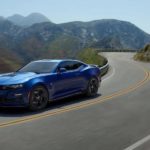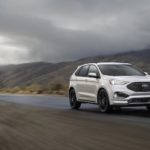Muscle cars have been called a dying breed since the days when most manufacturers stopped making them, but they live on in the three remaining ancestors of the original pony cars that once roamed the streets. Two of those steeds fall into a price range starting below $30K, yet in their upper trims, they boast zero to 60 times that once would have only been seen at the track. To have a pony car that can both handle a straightaway and hug a curving highway may seem like asking too much, but muscle cars have come a long way from those original drag racers burning rubber at stoplights. Of the two most affordable contenders, a comparison featuring the 2022 Chevy Camaro vs 2022 Ford Mustang will reveal the capability of the car best suited to speed and handling.
Live for the Moment Before It’s Gone
It’s no secret that auto manufacturers are working to move into electrifying their lineups. Ford has already done so with the Mustang Mach E, and Chevy is expected to switch the Camaro over to an electric platform in 2024, though details have yet to be revealed. For the moment, we still have a few traditional gas-powered engines available that offer up capability the original pony cars could never have imagined possible. In the early days, the Camaro and Mustang flagged zero to 60 times between 7-8 seconds at their fastest, and now the most high-performing (and street legal) of the 2022 models can achieve times of 3.5 seconds from the factory. And that’s not even considering those variants built for the track, like the new COPO Camaro or the Shelby GT500K.
Even though we may dream about cars that can flatten us to the back of the seat, they aren’t always practical if you just want to own a fun car that can serve as a daily driver. The fuel economy alone is reason enough to stick with a car that performs adequately on the way to work or around town yet still has the chops to deliver a grin-worthy experience for cruising. Truthfully, despite the admirable performance of the Mach E, electric cars still have a long way to go before they can be considered practical. After all, who has the time to sit at a rest stop on a long trip while you wait an hour for your car to charge its battery? Let’s not even go into the fact that cold weather eats away at driving range, among other frustrating issues still needing to be solved with electric cars. Thus, we must soak up the fleeting moments left to us before the wide-reaching extinction of gas-powered cars.

How the Chevy Engines Stack Up
Both Chevy and Ford have typically offered a vast number of ways to personalize their muscle cars, from appearance to performance. While that’s still true for 2022 models, engine options are not what they used to be. Chevy makes a 2.0-liter turbo inline-four the starting engine of the 2022 Camaro lineup, with a decent power output of 275 hp and 295 lb-ft of torque. For entry-level buyers who care more about the look of the Camaro and like the idea of less painful trips to the pump, this engine is not a bad option. After all, you get up to 30 MPG on the highway with this engine paired to an automatic transmission, and it goes from zero to 60 in 5.4 seconds. That’s pretty good for an affordable car, but if you actually care about performance, you’re not buying the entry-level engine. You’re climbing higher in the ranks.
Next on the options list for the 2022 Camaro is a 3.6-liter V6 that delivers 335 hp and 284 lb-ft of torque. Zero to 60 times for this engine get mildly better at 5.2 seconds, and fuel efficiency doesn’t suffer much, either, with up to 29 MPG on the highway. A V6 engine has a lot of factors going for it, not the least of which is how readily it accelerates when you want the power. Still, this engine isn’t going to impress anyone. If we’re being honest, the engine most enthusiasts are going to want is the thirsty V8 that can go from zero to 60 in 4.0 seconds flat. The 6.2-liter LT1 makes an impressive 455 hp with 455 lb-ft of torque, and it has an equally impressive rumble everyone likes to hear as it idles its time. It may be rougher on your wallet with a lower 26 MPG on the highway, but it’s no worse than those gas-guzzling SUVs everyone is driving these days.
At the top of the range, Chevy offers one final trophy engine that has enough power to hit the track if it wants, but it can still be driven on the road. The supercharged LT4 V8 races from zero to 60 in the Camaro’s quickest time of 3.5 seconds, and it makes a ripping 650 hp with 650 lb-ft of torque. Even paired to the automatic transmission, this engine only gets 21 MPG on the highway, but neither this engine nor the LT1 is likely to be as satisfying to drive without the fun of the manual, which drops efficiency down a point or two. With all of these options from Chevy covered, it’s time to see what Ford has to offer for the 2022 Mustang.
Engine Options from Ford
Where Chevy still offers four engines, Ford seems to be backing off the options for buyers of the Mustang in 2022. Recent press releases from Ford shared new special editions that would be available for the lineup, but those are appearance-based choices for the most part. Looking at the available engines may leave buyers wanting more since the entry-level option is a 2.3-liter inline-four EcoBoost, and Ford simply tunes it differently for mid-level trims to gain more power. The EcoBoost engine makes either 310 or 330 hp with 350 lb-ft of torque, which certainly beats the entry-level Camaro numbers in terms of power. Even fuel efficiency is higher, with the automatic getting up to 32 MPG on the highway, but a four-cylinder engine isn’t what true enthusiasts want in a pony car.
Ford takes buyers next is straight into V8 territory with the 5.0-liter Coyote engine, but it’s saved for the GT variant that costs close to $40K. Fuel efficiency for the Coyote only hits 24 MPG on the highway, though it does have an impressive output of 450 hp and 410 lb-ft of torque, with zero to 60 times of a bit over 4 seconds. Like the Camaro, Ford gives buyers the option of the ultimate in performance for the street with the Mach 1, which tunes the Coyote engine to get a higher output of 470 hp at its best.
Unfortunately, this fine-tuning costs nearly $55K for the pleasure of its capability, which doesn’t seem worth it in comparison to the much less expensive GT if you don’t plan to take it to the track. Then again, if you want a track-based pony car from Ford, you would go for the Shelby GT500, which can range up to nearly $80K for 750 horses. Or you could save your money and buy the Camaro ZL1 for about $63K and call it good.
Handling for the Road
Engines are the foundation of a car’s performance, but any enthusiastic driver knows there is a lot of engineering that needs to work hand in glove with the rest of the car to make it fun to drive. No matter what a car’s history looks like, what matters today is how it sticks to the pavement. While Ford does a great job of building the Mustang, and it beats out the Camaro in terms of visibility, the Camaro is just more balanced when cruising winding ribbons of road. Buyers are getting more choices for performance from engines, and pricing is better across the board with Chevy. Truthfully, the 2022 Camaro is the better choice for all-around performance, even in terms of ride quality and certainly in terms of affordability.





